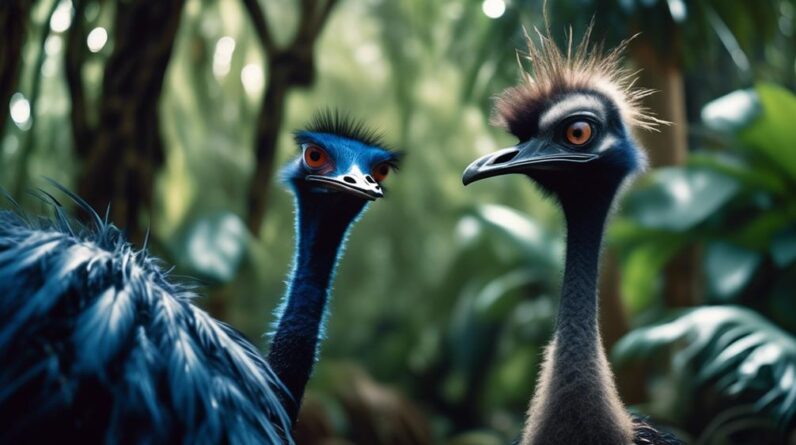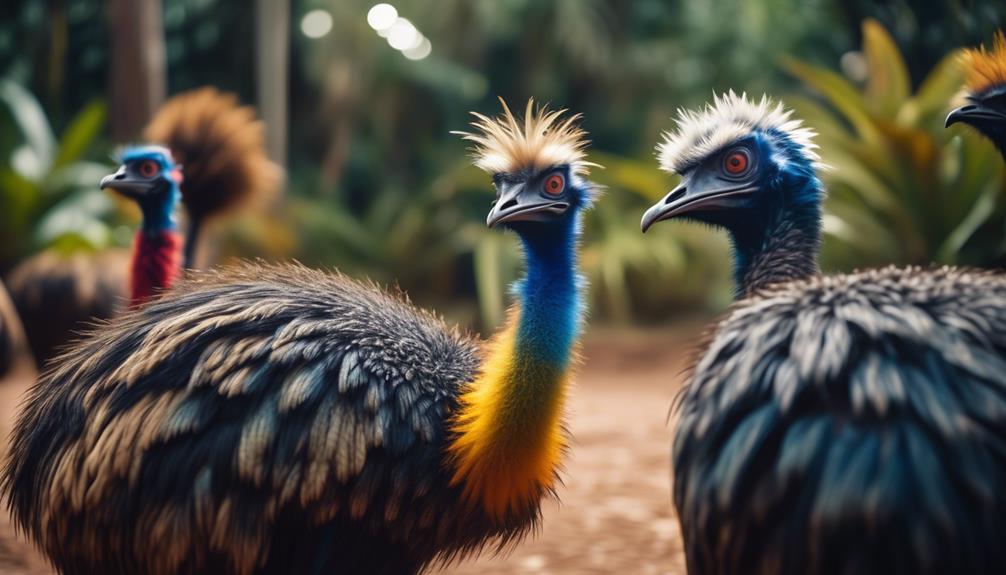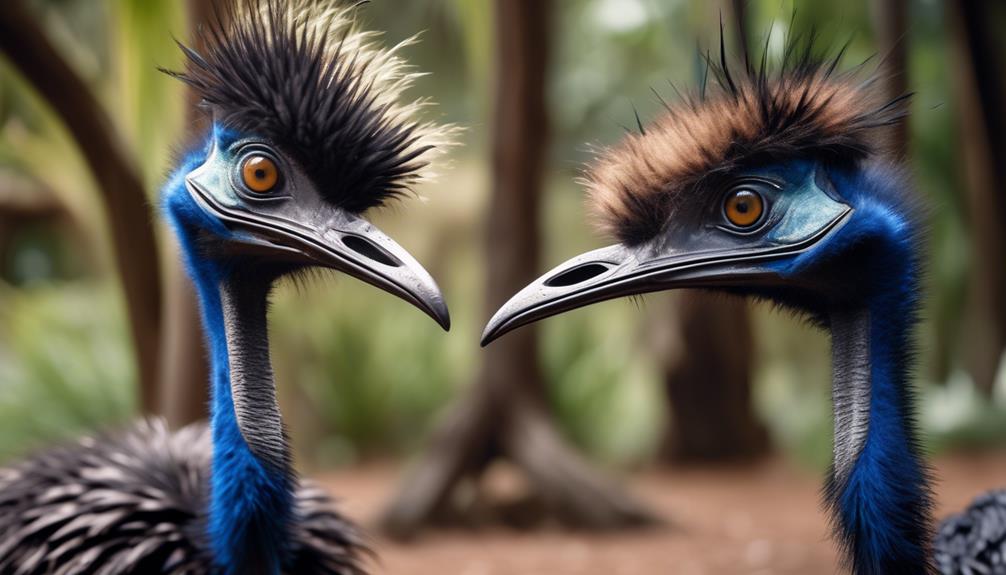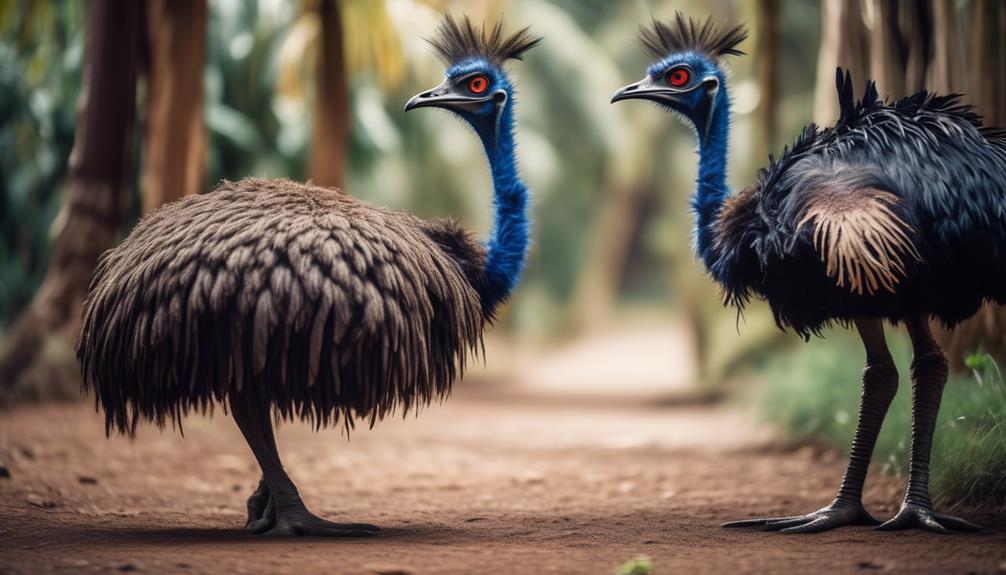
Did you know that both the emu and the cassowary are considered giants in the avian world?
These fascinating birds share some similarities, but also have distinct characteristics that set them apart.
From their physical appearance to their unique adaptations for survival, there is much to explore and compare.
So, let's take a closer look at these giants of the bird kingdom and uncover the intriguing differences that make them so captivating.
Key Takeaways
- Emus and cassowaries have distinct physical appearances, with emus being larger and covered in soft, shaggy feathers, while cassowaries have a glossy black appearance with a distinctive casque on their head.
- Emus are well-adapted to the extreme temperatures of the Australian outback, while cassowaries are found in tropical rainforests.
- Emus are opportunistic feeders and consume a variety of plants, insects, and carrion, while cassowaries heavily rely on fruits for nutrition and play a crucial role in seed dispersal.
- Emus and cassowaries are both large and fast birds, with emus reaching speeds of up to 30 miles per hour and cassowaries reaching speeds of around 31 miles per hour. They have adapted for agility and maneuverability in their foraging and defense.
Physical Appearance
When comparing the physical appearances of the emu and the cassowary, it's evident that both species possess distinct features that contribute to their unique characteristics. These features have evolved over time due to their shared evolutionary history as flightless birds.
The emu, standing at an average height of around 6 feet, is the largest bird native to Australia. Its body is covered in soft, shaggy feathers that are mainly brown in color, providing excellent camouflage in its natural habitat. The emu's head is small in proportion to its body, with a sharp beak that's adapted for feeding on plants and insects. Its long, slender neck allows it to reach vegetation at varying heights.
In contrast, the cassowary is slightly smaller in size, averaging around 5 to 6 feet tall. Its body is covered in coarse, black feathers that have a glossy appearance. The most distinctive feature of the cassowary is its large, helmet-like casque on top of its head, which is believed to play a role in communication and protection. The cassowary also has a vibrant, blue-colored neck and a bright red wattle that hangs down from its throat.
When compared to other flightless birds, such as ostriches and rheas, both the emu and the cassowary exhibit unique physical characteristics that set them apart. These features have developed through natural selection and adaptation to their specific environments, allowing them to thrive in their respective habitats.
Habitat and Distribution
The habitat and distribution of the emu and the cassowary are influenced by a combination of factors, including their unique adaptations and geographical locations.
Emus are native to Australia and are found in various habitats such as savannas, shrublands, and forests. They're well-adapted to withstand the extreme temperatures of the Australian outback, with their long legs and featherless necks helping them dissipate heat. Emus have a relatively stable distribution and are known to be sedentary, rarely migrating long distances.
On the other hand, cassowaries are found in the tropical rainforests of New Guinea and northeastern Australia. They've a more restricted distribution compared to emus, as their habitat is limited to dense vegetation and lowland forests. Cassowaries play a crucial role in seed dispersal, as they consume a wide variety of fruits and excrete the seeds intact over a wide area. This ecological impact is vital for the maintenance of forest diversity.
In terms of migration patterns, emus and cassowaries display contrasting behaviors. While emus are non-migratory, cassowaries are known to have seasonal movements in search of food resources. They cover significant distances during these movements, which can have implications for their population dynamics and genetic diversity.
Understanding the habitat and distribution of emus and cassowaries is vital for their conservation and management. It's important to protect their respective habitats and ensure the availability of suitable resources to sustain their populations.
Diet and Feeding Habits

Emus and cassowaries have distinct diet and feeding habits that are shaped by their unique ecological niches. These giants of the bird world have developed different foraging strategies to acquire their food and meet their nutritional needs.
Emus, with their long legs and necks, are well adapted for grazing. They primarily feed on grasses, seeds, fruits, and flowers. They use their sharp beaks to pick at vegetation, often plucking the leaves from plants. Emus are opportunistic feeders and will also consume insects, small reptiles, and even carrion when available. Their flexible diet allows them to adapt to different environments and survive in a variety of habitats.
On the other hand, cassowaries have a more specialized diet. They're frugivores and rely heavily on fruits for their nutrition. They've a unique feeding habit where they swallow the fruits whole, digest the pulp, and excrete the seeds intact. This behavior plays a crucial role in seed dispersal, benefiting the local ecosystem by helping to regenerate plant species. Additionally, cassowaries also consume small animals, such as insects and small vertebrates, which supplement their diet with protein.
Size and Weight
With their distinct diet and feeding habits discussed, we can now turn our attention to the size and weight of emus and cassowaries. When comparing the giants of the bird world, it's evident that both species possess remarkable dimensions.
Emus, standing at an average height of 5 to 6 feet, tower over most other birds. However, they're surpassed by the cassowary, which can reach an astonishing height of up to 6.6 feet.
In terms of weight, emus weigh around 90 to 130 pounds, while cassowaries can tip the scales at a hefty 120 to 160 pounds. The impressive size and weight of these birds can be attributed to their robust body structure, muscular legs, and large frames.
Both species possess long, strong legs, which enable them to move swiftly and cover great distances. These adaptations are crucial for foraging, escaping predators, and defending their territories.
The comparative anatomy of emus and cassowaries provides insights into their evolutionary strategies and ecological impact. The impressive size and weight of these giants contribute to their unique roles in their respective ecosystems.
Speed and Agility

When comparing the speed and agility of emus and cassowaries, it's clear that both species possess remarkable athletic abilities. These giant birds are built for speed and maneuverability, allowing them to navigate their environments with precision and grace.
Here are some key observations regarding their running speed and maneuverability:
- Emus and cassowaries can reach impressive running speeds, with emus capable of running up to 30 miles per hour and cassowaries reaching speeds of around 31 miles per hour.
- Both species exhibit exceptional agility, effortlessly changing directions while maintaining their speed. This agility enables them to navigate through dense vegetation and avoid obstacles with ease.
- Emus and cassowaries utilize their long legs and powerful muscles to generate the necessary force for their swift movements. Their legs are perfectly adapted for quick bursts of speed and sudden changes in direction.
- The lightweight and streamlined bodies of these birds contribute to their impressive speed and agility. Their aerodynamic forms minimize drag, allowing them to maintain their momentum while running.
- The joint structure in their legs provides additional stability and flexibility, enhancing their overall maneuverability.
Reproduction and Life Cycle
During the reproduction and life cycle of both emus and cassowaries, several key stages and behaviors can be observed. These giant birds have different reproduction strategies and parenting behaviors that contribute to the survival of their species.
| Reproduction Strategies | Emu | Cassowary |
|---|---|---|
| Mating System | Polygamous | Monogamous |
| Breeding Season | All year round | Seasonal (dry season) |
| Nesting Habits | Male builds the nest | Female builds the nest |
| Egg Incubation | Male incubates the eggs | Male incubates the eggs |
| Hatching and Parenting | Male cares for the chicks | Male cares for the chicks |
Emus have a polygamous mating system, where males mate with multiple females. They breed all year round, and the male takes the responsibility of building the nest. After the female lays the eggs, the male takes over the incubation process, which lasts for about 56 days. Once the eggs hatch, the male is also responsible for caring for the chicks, protecting them from predators and teaching them important survival skills.
On the other hand, cassowaries follow a monogamous mating system, where a male and female form a pair bond. They have a specific breeding season during the dry season. The female builds the nest and lays the eggs, which are then incubated by the male for around 50 days. After hatching, the male continues to care for the chicks, providing them with food and protection until they are independent.
These different reproductive strategies and parenting behaviors contribute to the survival and success of both emus and cassowaries, ensuring the continuation of their species.
Social Behavior and Communication

Emus and cassowaries exhibit distinct social behavior and communication patterns, which play a crucial role in their survival and interactions within their respective habitats. Understanding their communication methods and social hierarchies provides insights into their complex behaviors.
Here are some key observations:
- Vocalizations and sound production: Both emus and cassowaries produce a range of vocalizations to communicate with each other. Emus emit deep booming sounds, while cassowaries produce low-frequency rumbles and throaty calls. These vocalizations serve as territorial signals, mating calls, and warnings of potential danger.
- Social hierarchies and dominance interactions: Emus live in small groups called mobs, typically consisting of one dominant male and several females. The dominant male establishes his position through displays of dominance, such as puffing up his feathers and making low growling sounds. In contrast, cassowaries are solitary birds, with males being territorial and fiercely defending their space.
- Courtship rituals: Emus engage in elaborate courtship displays, where males perform a dance by swaying, circling, and drumming their wings. Cassowaries, on the other hand, rely on visual displays, such as head bobbing, bill clacking, and jumping, to attract mates.
- Parental care: Emus and cassowaries both exhibit remarkable parental care. Male emus incubate the eggs and rear the young, while female cassowaries lay their eggs in the nests of dominant males, who then incubate and raise the chicks.
- Communication through body language: Both species use body language to communicate, such as head movements, postures, and feather displays. These signals convey messages of aggression, submission, and courtship.
Emus and cassowaries demonstrate fascinating social behavior and communication methods that contribute to their survival and interactions within their habitats. Understanding these patterns provides valuable insights into the complex lives of these magnificent birds.
Defense Mechanisms
The social behavior and communication patterns of emus and cassowaries are intricately connected to their defense mechanisms, which play a crucial role in ensuring their survival and protection within their respective habitats. Both species have developed remarkable camouflage strategies that allow them to blend seamlessly into their surroundings, making it difficult for predators to detect them.
Emus, with their brown feathers and slender bodies, are perfectly suited for hiding in the vast Australian outback. Their ability to flatten themselves against the ground and remain still further enhances their camouflage.
On the other hand, cassowaries rely on their vibrant blue and black feathers to blend in with the dense foliage of the rainforest. Their large size and robust build may seem cumbersome, but their camouflage allows them to remain inconspicuous while they forage for food. This ability to conceal themselves effectively gives emus and cassowaries a significant advantage when it comes to evading potential threats.
In addition to their camouflage strategies, both emus and cassowaries exhibit aggressive behaviors as a defense mechanism. Emus are known to kick and peck at their adversaries, using their strong legs and sharp beaks as weapons. Cassowaries, on the other hand, have powerful legs equipped with sharp claws that they can use to deliver powerful kicks. These aggressive behaviors serve as a warning to predators and help deter them from approaching.
Adaptations for Survival

To ensure their survival in their respective habitats, emus and cassowaries have developed various adaptations for navigating their environments and acquiring resources. These adaptations provide them with evolutionary advantages and shape their behavioral patterns.
- Powerful Legs: Both emus and cassowaries have evolved strong and muscular legs, which allow them to run at high speeds and cover long distances. This enables them to escape from predators or chase down prey efficiently.
- Long Neck and Beak: The long neck and beak of both species serve multiple purposes. They allow emus and cassowaries to reach vegetation that's otherwise inaccessible, providing them with a diverse diet. Additionally, their beaks are powerful weapons that can be used for defense or to obtain food by striking with force.
- Camouflage: Emus and cassowaries have plumage that helps them blend into their surroundings. This camouflage provides them with a level of protection against predators. By blending in with their environment, they can avoid detection and increase their chances of survival.
- Agility: Both species exhibit remarkable agility, allowing them to maneuver through dense vegetation and navigate challenging terrain. This agility helps them evade predators and chase down prey effectively.
- Parental Care: Emus and cassowaries display strong parental care. They invest time and energy in raising their young, ensuring their survival and passing on their genes to the next generation.
These evolutionary advantages and behavioral adaptations have enabled emus and cassowaries to thrive in their respective habitats, increasing their chances of survival and ensuring the continuation of their species.
Threats and Conservation Status
Having discussed the adaptations for survival in emus and cassowaries, it's essential to now examine their threats and conservation status in order to gain a comprehensive understanding of the challenges these species face.
Both the emu and the cassowary face significant threats, largely due to human impact. Habitat loss is a primary concern for these species, as deforestation and land conversion for agriculture continue to diminish their natural habitats. The conversion of forests into farmland has resulted in fragmentation of their habitats, making it difficult for emus and cassowaries to find suitable areas for foraging, breeding, and nesting. Additionally, human activities such as hunting and road accidents pose a significant threat to their survival.
In response to these threats, conservation efforts have been implemented to protect these remarkable birds. These efforts include the establishment of protected areas, habitat restoration projects, and public awareness campaigns to educate communities about the importance of conserving these species.
Despite these efforts, the conservation status of emus and cassowaries remains a concern. Continued monitoring, research, and active conservation measures are necessary to ensure the long-term survival of these unique giants.
Conclusion

In conclusion, the threats faced by emus and cassowaries highlight the urgent need for ongoing conservation efforts. These two remarkable giant birds share many characteristics, but their behavioral differences set them apart. Let's take a closer look:
- Physical Appearance: Emus have a slender body covered in brown feathers, while cassowaries have a stockier build and sport vibrant blue and black feathers.
- Habitat: Emus are found mainly in Australia, inhabiting a variety of environments, including grasslands and woodlands. Cassowaries, on the other hand, reside in the rainforests of New Guinea and northeastern Australia.
- Feeding Habits: Emus are opportunist feeders, consuming a wide range of plant material as well as insects and small vertebrates. Cassowaries, however, have a unique role as seed dispersers, as their large bodies allow them to swallow fruits whole and spread the seeds through their droppings.
- Social Structure: Emus live in small groups or as solitary individuals, while cassowaries are more territorial and tend to be solitary as well.
- Reproduction: Emus lay their eggs in shallow nests, which are incubated by the male. In contrast, cassowaries lay their eggs in a mound of vegetation, and it's the male who incubates and raises the chicks.
Understanding these characteristics and behavioral differences is crucial for developing effective conservation strategies for both emus and cassowaries. By protecting their habitats and implementing conservation measures, we can ensure the survival of these magnificent birds for future generations.
Frequently Asked Questions
Are Emus and Cassowaries Related?
Emus and cassowaries are indeed related, belonging to the same family of flightless birds called ratites. Their shared evolution is evident in their similar physical features, but they also have distinct differences in appearance and behavior.
What Is the Lifespan of Emus and Cassowaries?
You'll be fascinated to learn that the lifespan of emus and cassowaries differs significantly. While emus typically live up to 10-20 years, cassowaries can live for 40-50 years, showcasing their remarkable longevity in comparison.
Can Emus and Cassowaries Fly?
Emus and cassowaries, two giant birds, possess distinct physical differences that impact their flying abilities. While emus cannot fly due to their large size and reduced wing muscles, cassowaries maintain limited flight capabilities for short distances.
How Do Emus and Cassowaries Defend Themselves Against Predators?
When it comes to defending themselves against predators, emus and cassowaries have developed some fascinating strategies. They rely on their impressive size and speed, as well as their sharp claws, to deter potential threats.
Are Emus and Cassowaries Kept as Pets?
Keeping emus as therapy animals is becoming more popular due to their gentle nature and therapeutic benefits. However, it is important to note that cassowaries are not commonly kept as pets due to their aggressive behavior and the legal restrictions surrounding their ownership.
Conclusion
In conclusion, while both the emu and cassowary are remarkable giants of the bird world, they differ in certain aspects.
One interesting statistic is their size and weight, with emus reaching an average height of 6.2 feet and weighing around 120 pounds, while cassowaries stand at an average height of 5.6 feet and weigh around 130 pounds.
This difference highlights the unique adaptations and evolutionary paths these two species have taken to survive in their respective habitats.





